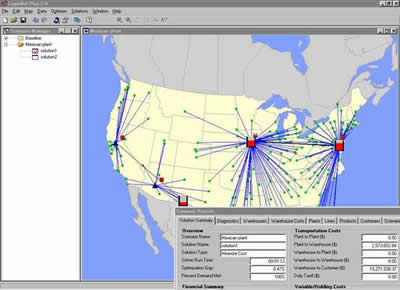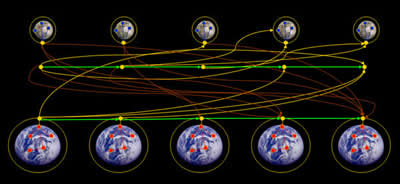Commercial vs. Interplanetary Supply Chains
Supply chains of enterprises exhibit a notorious complexity that stems from complex bill of materials and the geographic dispersion of today’s global economy. It is thus no surprise that many companies use information technology and the associated decision support systems to manage their supply chains. In addition, operating an efficient supply chain has in many cases become a competitive advantage (C. Heinrich and D. Simchi-Levi, Do IT investments really pay off?). The high level decisions of facility location, efficient transportation, etc, can easily be mapped into interplanetary logistics. In the latter, warehousing can be done at Lagrangian points and transportation corresponds to moving various spacecraft on trajectories. Basic modeling principles are similar in the two settings.


Push/Pull Supply Chains
In recent years companies are pressured from investors to reduce inventory, which resulted in the notion of so-called push and pull strategies. Many enterprises today operate a mixture of these two principles called the push/pull supply chains, where the inventory in higher echelons is pushed and the inventory in lower echelons is pulled (D. Simchi-Levi, E. Simchi-Levi, Inventory positioning: exploring push and pull supply chains). Such a concept explores the trade-off between cost and customer service. The existing space logistics operations rely solely on the push concept, i.e., the supply is pushed downstream into the space. Due to the excessive transport time to Mars, the push strategy seems to be the optimal choice for Mars exploration. On the other hand, transport times are much shorter for Moon exploration and therefore the push/pull strategy combined with risk pooling could be beneficial for such missions. Consider, for example, spare parts for spacecrafts. From the risk pooling perspective, it could be advantageous to maintain a repository of selected spare parts at the Low Earth Orbit. These parts can then be pulled from Earth and pushed into the Lagrangian points or Lunar orbits. While the transport time from Earth to the Low Earth Orbit is very short, it is extremely costly and therefore such a strategy needs to be carefully studied.
Risk Pooling
Another result of risk pooling are various strategies to incorporate design decision into supply chain management. The well known principles of delay differentiation and commonality are often used in this context. In space logistics, these concepts are applicable as well. In today’s environment vehicles are designed without considerations to logistics. Conceptually small changes to designs can yield substantial cost savings in logistics. For example, a larger payload capacity of a vehicle can potentially result into combining two loads to a single vehicle and thus saving one vehicle.
Applicability to Space Logistics
While all these concepts can potentially be translated into space logistics, there are also principles that are unique to the interplanetary supply chains. The first distinction is in the fact that in the interplanetary setting supply can gain or loose mass and volume during transport (consider crew members that consume food and water). The second difference deals with fuel. While the transportation fuel is typically not explicitly taken into account in commercial supply chains, fuel is a driving force in space operations. Most of a mass of a spacecraft is contributed to fuel and a spacecraft cannot move along a trajectory unless it starts with sufficient amount of fuel. On Earth, a truck can easily be refueled during transport, which is possible in space only under very limited circumstances (and not possible at all during the act of transporting).
Summary
To summarize, several concepts used in commercial supply chains are currently not being used in the interplanetary setting. With careful analysis and studies many of them could be beneficial. On the other hand, interplanetary setting yields unique principles and challenges that are not present in the terrestrial setting.
